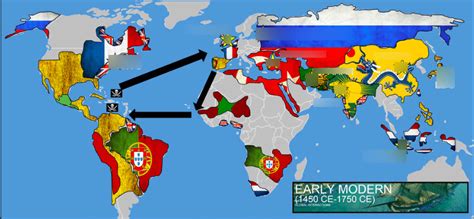Introduction
Throughout history, maritime empires have played a pivotal role in shaping global trade, politics, and culture. From the ancient Phoenicians to the modern British Empire, these empires have displayed common characteristics that have contributed to their success and legacy. This quizlet will explore the key characteristics that define maritime empires, providing a comprehensive understanding of their nature and impact.

Economic Considerations
1. Extensive Mercantile Networks
Maritime empires establish vast trading networks that connect distant regions, facilitating the exchange of goods, resources, and ideas. These networks are crucial for economic growth and wealth accumulation.
2. Control of Strategic Sea Lanes
Maritime empires often seize control of strategic sea lanes, allowing them to regulate trade and protect their commercial interests. By dominating these waterways, they can enforce tariffs, impose tolls, and prevent competitors from accessing vital resources.
3. Establishment of Port Cities
Maritime empires establish port cities as centers of trade and commerce. These cities serve as hubs for the exchange of goods, providing infrastructure for shipping, trading, and financial transactions.
4. Maritime Technology
Maritime empires possess advanced ship designs, navigation techniques, and shipbuilding technologies. These advancements enable them to traverse vast oceans, explore new territories, and establish global connections.
Political and Military Aspects
5. Centralized Authority
Maritime empires are typically governed by a centralized authority, either a monarchy or a republic. This authority exercises control over both domestic and overseas territories, ensuring stability and coherence in decision-making.
6. Naval Supremacy
Maritime empires maintain a strong navy to protect their trade routes, expand their territories, and deter potential rivals. A powerful navy ensures military dominance and allows for swift and effective projection of power across vast distances.
7. Expansionist Policies
Maritime empires engage in expansionist policies to acquire new territories, resources, and markets. Colonialism, imperialism, and the establishment of protectorates are common approaches used to extend their reach.
8. Maritime Defense
Maritime empires invest in coastal fortifications, coastal patrols, and other defensive measures to protect their shorelines and trade routes from attack by rival powers or pirates.
Cultural and Social Impacts
9. Cultural Exchange
Maritime empires facilitate cultural exchange between different regions, spreading ideas, technologies, and art forms. This exchange often leads to the emergence of new cultural identities and global influences.
10. Religious Influence
In some cases, maritime empires have been influenced by religious motivations, seeking to spread their信仰 or gain control of pilgrimage routes. Religious factors can shape imperial policies and provide a source of legitimacy for expansion.
11. Migration and Colonization
Maritime empires often engage in large-scale migration and colonization, establishing settlements and outposts in distant lands. These activities can lead to population transfers, displacement of indigenous peoples, and the spread of European culture and values.
12. Exploration and Discovery
Maritime empires sponsor expeditions to explore new regions, expand knowledge of the world, and search for new resources. These expeditions often contribute to scientific discoveries, geographic knowledge, and the expansion of imperial territories.
Quizlet Questions
-
Which of the following is NOT a characteristic of maritime empires?
(a) Extensive mercantile networks
(b) Lack of centralized authority
(c) Control of strategic sea lanes
(d) Naval supremacy -
How do maritime empires contribute to economic growth?
(a) By establishing port cities
(b) By controlling trade routes
(c) By promoting cultural exchange
(d) All of the above -
What is the role of maritime defense in a maritime empire?
(a) To protect trade routes and shorelines
(b) To expand imperial territories
(c) To facilitate cultural exchange
(d) To support religious missions -
How did maritime empires influence global culture?
(a) By trading exotic goods
(b) By introducing new technologies
(c) By spreading religious beliefs
(d) All of the above -
Which of the following is an example of an expansionist policy used by maritime empires?
(a) Colonization
(b) Imperialism
(c) Protectorates
(d) All of the above
Table of Maritime Empires
| Empire | Time Period | Notable Characteristics |
|---|---|---|
| Phoenician Empire | 1200-539 BCE | Extensive trade networks, advanced shipbuilding, establishment of port cities |
| Athenian Empire | 5th century BCE | Naval supremacy, democratic government, cultural influence |
| Roman Empire | 27 BCE-476 CE | Vast land and sea territories, centralized authority, legal system |
| Venetian Republic | 11th-18th centuries | Maritime trade, naval prowess, control of the Mediterranean Sea |
| Portuguese Empire | 15th-19th centuries | Global exploration, establishment of colonies, spread of Christianity |
| Spanish Empire | 16th-19th centuries | Conquest of the Americas, vast colonial territories, religious influence |
| Dutch Empire | 17th-18th centuries | Trade-based economy, naval power, global reach |
| British Empire | 19th-20th centuries | Industrialization, empire on which the “sun never sets,” dominance of global trade |
Table of Economic Characteristics of Maritime Empires
| Characteristic | Description |
|---|---|
| Mercantile Networks | Extensive trading networks connecting distant regions |
| Control of Sea Lanes | Regulation of trade and enforcement of tariffs on strategic waterways |
| Port Cities | Centers of trade, commerce, and financial transactions |
| Maritime Technology | Advanced shipbuilding, navigation techniques, and naval innovations |
Table of Political and Military Characteristics of Maritime Empires
| Characteristic | Description |
|---|---|
| Centralized Authority | Governing body exercising control over domestic and overseas territories |
| Naval Supremacy | Strong navy for protection of trade routes, expansion, and deterrence |
| Expansionist Policies | Acquisition of new territories, resources, and markets |
| Maritime Defense | Coastal fortifications, coastal patrols, and other measures to protect shorelines and trade routes |
Table of Cultural and Social Characteristics of Maritime Empires
| Characteristic | Description |
|---|---|
| Cultural Exchange | Spread of ideas, technologies, and art forms across regions |
| Religious Influence | Influence of religious motivations on imperial policies and expansion |
| Migration and Colonization | Population transfers and establishment of settlements in distant lands |
| Exploration and Discovery | Sponsorship of expeditions to explore new regions and expand knowledge of the world |
Conclusion
Maritime empires have played a profound role in shaping the course of human history. By understanding the key characteristics that define these empires, we can better comprehend their rise, influence, and decline. The economic, political, military, cultural, and social aspects of maritime empires have left a lasting legacy on global trade, politics, and culture, continuing to influence the world today.
